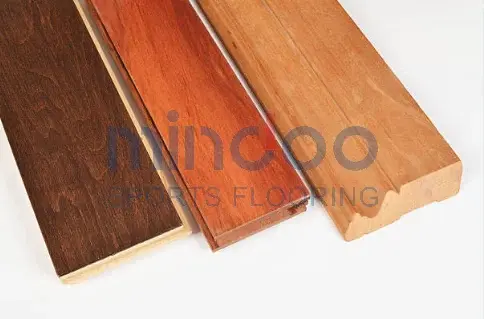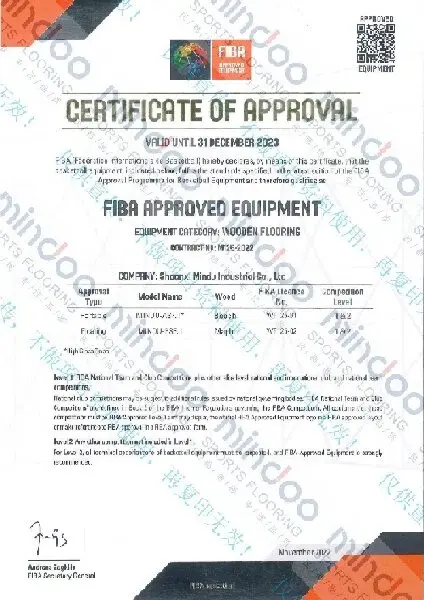What best practices should OEM flooring makers follow for maple?
For a long time, maple wood flooring has been the best choice for sports venues, especially basketball fields and gyms. Because it is long-lasting, absorbs shock, and looks good, it is a great surface for sports. OEM (Original Equipment Manufacturer) flooring manufacturers must follow certain best practices in order to make high-quality maple flooring. This complete guide will look at the most important things OEM flooring makers should do to make sure they make high-quality maple wood flooring.
Sourcing high-quality maple lumber for sports floors
The quality of the raw materials is what makes great maple wood floors possible. OEM flooring makers must make getting high-quality maple lumber a top priority if they want their goods to work well and last a long time.
Selecting the right maple species

Because of its density, hardness, and resilience to wear, hard maple, also known as Acer saccharum, is the species of maple that is most often used for sports flooring. When it comes to ensuring maximum performance, original equipment makers have to concentrate on acquiring this particular kind of maple.
Proper lumber grading
The adherence to grading standards that are conventional in the industry, such as those established by the National Hardwood Lumber Association (NHLA), is of the utmost importance. It is recommended that makers of maple wood flooring use timber grades that either meet or surpass the specifications for sports flooring. These grades often fall within the "First and Seconds" (FAS) or "Select" categories.
Moisture content control
Maintaining proper moisture content in the maple lumber is vital for dimensional stability. OEM flooring makers should ensure that the lumber is kiln-dried to a moisture content between 6% and 9%, which is ideal for indoor use and helps prevent future warping or shrinkage.
Manufacturing techniques to enhance maple durability
Once high-quality maple lumber has been sourced, OEM flooring makers must employ advanced manufacturing techniques to maximize the durability and performance of the final product.
Precision milling
The use of cutting-edge milling technology guarantees that every single maple flooring board is cut according to the precise parameters laid forth. This accuracy helps to ensure that the boards are a close fit with one another, which in turn reduces the likelihood of gaps or unevenness in the floor that has been laid.
Multi-step sanding process
In order to get a surface that is smooth and consistent, it is necessary to do a complete sanding operation. Sanding should be done in a multi-step process, beginning with coarse-grit sandpaper and advancing to finer grits, in order to get a faultless finish. Original equipment makers should apply this approach.
Advanced finishing techniques
When it comes to safeguarding the maple wood flooring and improving its beauty, the application of a finish of excellent quality is very necessary. Because of their longevity and minimal volatile organic compound (VOC) emissions, UV-cured finishes and polyurethane coatings that are water-based are attractive alternatives. In order to get the highest possible level of protection, original equipment manufacturers of flooring should think about introducing multi-coat finishing methods.
Quality control checks for OEM maple flooring production
Rigorous quality control measures are essential to ensure that every piece of maple flooring meets the highest standards of performance and aesthetics.
Visual inspections
At every level of manufacturing, there should be a comprehensive visual inspection carried out by quality control professionals who have received training. This involves determining whether or not the raw timber has any flaws, evaluating the quality of the milling and sanding processes, and determining whether or not the finish application is consistent.
Moisture content verification
For the purpose of ensuring that the flooring stays within the ideal range of 6-9% moisture content during the production process, it is important to do regular moisture content inspections. In order to do this, calibrated moisture meters may be used.
Dimensional accuracy testing
In order to ensure that every plank is in accordance with the prescribed dimensions, original equipment manufacturers of flooring should adopt accurate measuring techniques. When it comes to ensuring a proper fit during installation, this includes checking the tolerances for thickness, width, and length if necessary.
Delivering consistent color and grain across batches
Achieving uniformity in color and grain patterns is crucial for creating a cohesive and attractive maple wood floor.
Color sorting and matching
A color sorting mechanism may be used to assist in the grouping of maple boards that have similar colors. The use of this procedure guarantees that the look of flooring that has been laid in the same area remains uninterrupted. To make this procedure more efficient, original equipment makers have to make investments in cutting-edge color-matching technologies.
Grain pattern selection
Enhancing the overall attractiveness of the floor may be accomplished by selecting maple planks with care and arranging them in a manner that is dependent on the grain patterns. Original equipment manufacturers (OEMs) of flooring should provide their employees with training to identify and categorize grain patterns that are similar in order to achieve a more consistent look.
Batch tracking
The ability to maintain uniformity between production runs is afforded to manufacturers by the use of a strong batch tracking system. It is especially crucial to keep this in mind for major projects that may include the installation of flooring in numerous stages.
Meeting international standards for hardwood sports floors
Adhering to international standards is crucial for OEM flooring makers to ensure their maple wood flooring meets the performance requirements for sports facilities.
FIBA and BWF certifications
Sports courts like basketball and badminton courts need flooring that has been approved by groups like the International Basketball Federation (FIBA) and the Badminton World Federation (BWF). These approvals make sure that the flooring fits certain requirements for how well it absorbs shock, bounces back balls, and changes shape vertically. OEM makers must try to meet or beat these standards because they ensure that the maple wood flooring gives players the best performance, lowering the risk of harm and making the game better.
Performance testing
To guarantee the durability and performance of maple wood flooring in sports facilities, regular performance testing is essential. These tests verify that the flooring complies with the standards set by global sports organizations. Tests should include shock absorption (≥53%), ball rebound (≥90%), and rolling load resistance (1500N), all of which are critical factors for ensuring the flooring’s ability to withstand the stresses of intense physical activity.
Environmental compliance
OEM flooring makers should make sure that their maple wood flooring not only meets performance standards but also meets environmental laws and certificates. To meet the rising demand for eco-friendly building products, you need to get certified by organizations like the Forest Stewardship Council (FSC) or LEED (Leadership in Energy and Environmental Design). Customers who care about the environment will like maple wood flooring that meets these standards. It also helps the building and sports businesses be more environmentally friendly.
Conclusion
By adhering to these best practices, original equipment manufacturers (OEMs) of flooring are able to create maple wood flooring of superior quality that is capable of satisfying the stringent standards of sports facilities. The production process is comprised of many steps, each of which plays an important part in the delivery of a good product. These steps include the procurement of premium timber, the implementation of stringent quality control methods, and the adherence to international standards. It will be essential for original equipment manufacturers (OEMs) to remain informed about the most recent techniques and technologies in order to maintain their competitive edge in the market for maple wood flooring as the industry continues to undergo an ongoing process of evolution.
FAQ
1. Why is maple wood such a great material for use as a flooring material for sports?
Because of its great density, strength, and good shock absorption capabilities, maple wood is an excellent choice for use as a flooring material for sports. This material offers a consistent playing surface, a decent bounce for the ball, and the toughness to survive extensive usage in situations that are conducive to athletics.
2. At what intervals should the refinishing of maple wood sports flooring be performed?
Maple wood sports flooring should be screened and recoated every three to five years, with a thorough sanding and refinishing advised every eight to ten years for best performance and beauty. The frequency of refinishing is determined by the amount of use the flooring receives.
3. What is the typical lifetime of a maple wood sports floor that has been inspected and maintained thoroughly?
A sports floor made of maple wood that is properly maintained may endure for at least 35 to 50 years. There are a number of important aspects that contribute to the longevity of the flooring, including regular cleaning, appropriate maintenance, and timely refinishing.
Choose Mindoo for Premium Maple Wood Flooring Solutions

Mindoo is one of the best makers of high-quality maple wood flooring for sports facilities. Our cutting-edge factory and dedication to finding the best maple timber make sure that every flooring system we make meets the highest standards of quality and performance. Mindoo is the best choice for all your maple wood flooring requirements since it has FIBA and BWF certifications, low prices, and a history of successful installations. Get in touch with our experienced team at sales@mindoofloor.com to talk about your project needs and find out why Mindoo is the best option for maple wood flooring manufacturers throughout the globe.
References
- National Hardwood Lumber Association. (2022). "Grading Standards for Maple Lumber in Flooring Production."
- International Basketball Federation. (2021). "FIBA Equipment & Venue Centre: Wood Flooring Standards and Certifications."
- Badminton World Federation. (2023). "BWF Flooring Specifications for Competition Venues."
- Forest Stewardship Council. (2022). "FSC Certification Guidelines for Hardwood Flooring Manufacturers."
- American Society for Testing and Materials. (2023). "ASTM F2772: Standard Specification for Athletic Performance Properties of Indoor Sports Floor Systems."
- Maple Flooring Manufacturers Association. (2021). "Best Practices for OEM Production of Maple Sports Flooring."